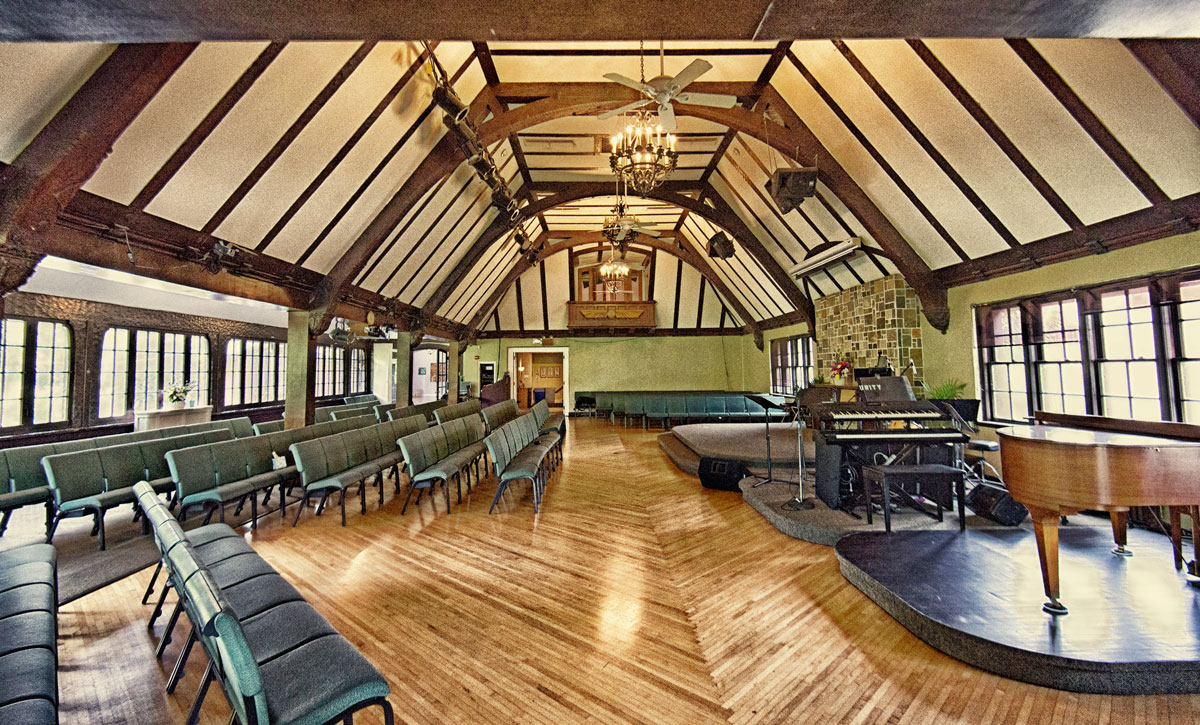What’s That Building? Unity Church
By Dennis Rodkin

What’s That Building? Unity Church
By Dennis RodkinUpdated at 6:50 p.m.
Tucked behind Emmerson Park on Chicago’s Far North Side is what looks like a grand Tudor manor house. But the brick building with a steep slate roof isn’t home to Welsh royalty, instead it’s the unusual place of worship for a small Christian congregation.
It won’t be a church much longer.
WBEZ has learned that Unity Chicago, the group that converted the building into a church in 1989, recently sold the property to Misericordia Heart of Mercy, a Catholic nonprofit that cares for people with developmental disabilities.

The congregation at Unity Chicago once had about 1,500 members. But dwindling numbers prompted Unity to sell the land for $7.5 million in April. Dan Ray, Unity Chicago’s building and business manager, said the congregation can stay at the church until October 2019.
Ray said the property needs at least $1 million in updates and maintenance, which the small congregation can’t afford.
Father Jack Clair, associate executive director of Misericordia, said demolition is “about 80 percent certain.” That’s because the building was never updated to comply with the Americans with Disabilities Act, which will be necessary if the property is to be used for housing, he said.
A grand clubhouse

Before it was a church, the building was the clubhouse for the Chicago Town and Tennis Club.
The clubhouse, which opened in 1925, was designed by George W. Maher. The building overlooked 16 tennis courts and included a carved stone plaque depicting a pair of tennis rackets high atop the stately chimney.
Maher, one of Chicago’s preeminent architects of the era, also designed dozens of houses in Kenilworth, Oak Park, Uptown, and Kenwood, among others.
The tennis club closed in the 1960s. The property was later occupied by an Elks Club, but was empty for about a decade when Unity Chicago took over the 3.5 acres of the property — including the clubhouse, extensive garden, and large parking lot.
Renovating the clubhouse

Unity Chicago, part of a modern Christian denomination that described itself as “the church of love, light and laughter,” was growing fast in the late-1980s thanks in part to a “New Age” movement that catered to baby boomers and drew heavily on Alcoholics Anonymous and other 12-step recovery programs.
Unity turned the tennis club’s dining room, a vast second-story room that overlooked the tennis courts, into its main sanctuary. Another old club room was converted into an art gallery and social hall.

The building still has the original stained glass, tile, and plaster detail. Outside, the parking lot is lit by cast-iron light poles built to light the old tennis courts.
A modern landmark
The building, which is now a remnant of the 1920s craze for city athletic and social clubs, is also significant in 21st century Chicago. On the first day same-sex marriage became legal in Illinois, June 1 2014, 40 couples got married or renewed vows they had taken in other states on the property.
The building’s future
Ward Miller, the head of Preservation Chicago, said his group has been trying to convince Misericordia to preserve the old building for use as a community center or dining hall and fill the gardens and parking lot with new housing.
Officials with Misericordia, the building’s new owner, said they already have enough common space. They plan to use the new space to house at least 100 people with developmental disabilities. While demolition is likely, they said nothing is certain until the architects complete their plans.
Editors note: This story was updated to include comment from Misericordia.
Dennis Rodkin is a real estate reporter for Crain’s Chicago Business and Morning Shift’s “What’s That Building?” contributor.
